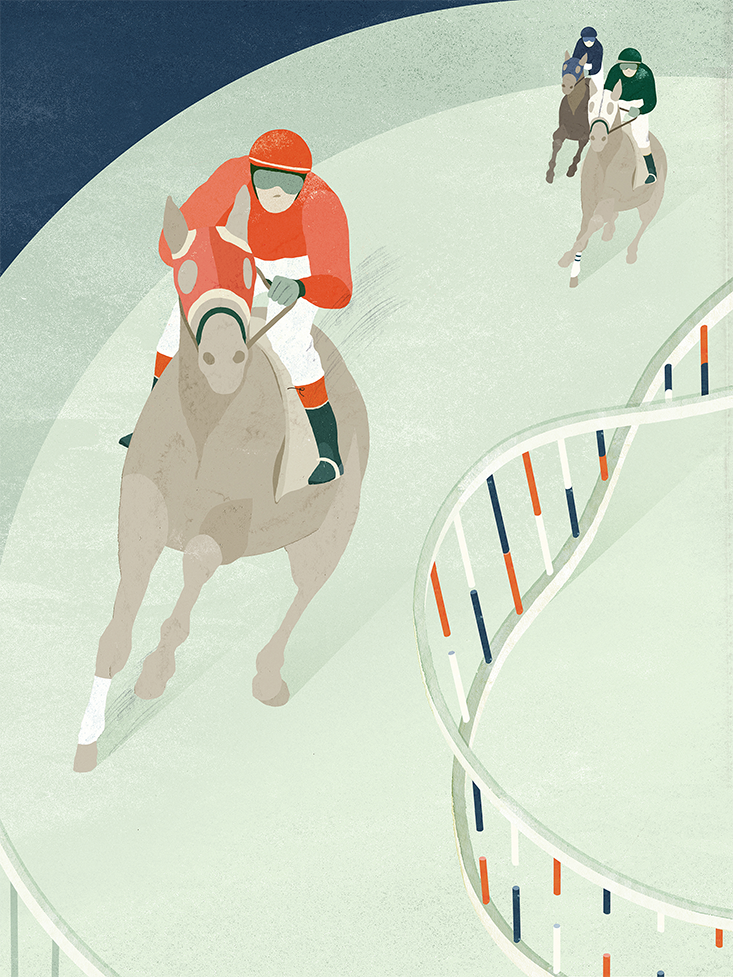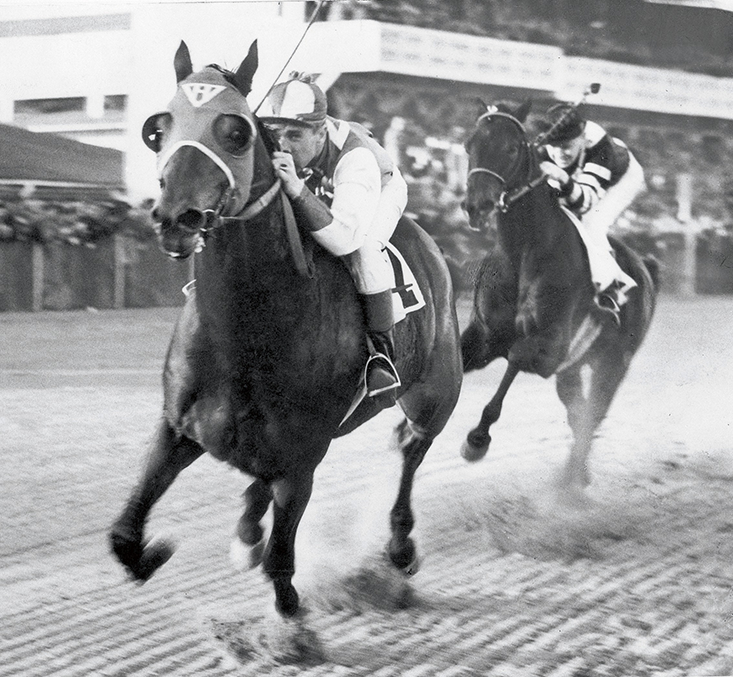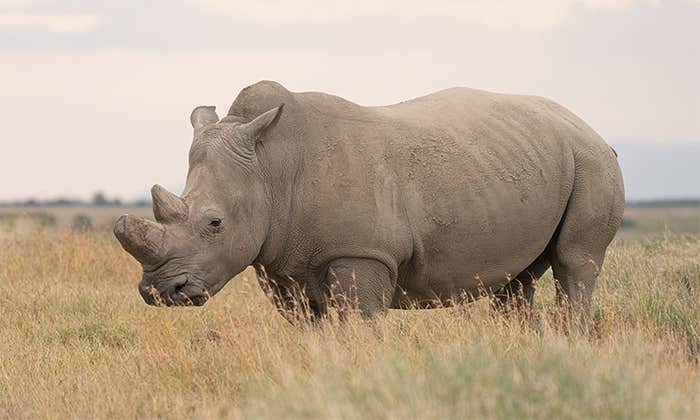Any trainer with good horse sense could have told you that Trading Leather was something special before he raced from the pack, overtook Galileo Rock, and galloped to victory in the prestigious Irish Derby last June. All one needed to do was take in the magnificent crevasse of muscle running down the back of his hindquarters, the length and architecture of his limbs, his inimitable dignity of motion.
But the legendary trainer who bred him, Jim Bolger, 72, had an extra reason to believe his prized colt was suited for the mid-distance race on the storied track at County Kildare. Bolger had Trading Leather tested for the “speed gene.” He knew, like an expectant mother who has an embryo tested to find out the sex of her baby, what distance Trading Leather was optimally suited to run and at about what age he’d be ready to run it.
Genetics testing has arrived in the world of thoroughbred horse racing. Bolger, whose name is synonymous with success in the fickle game of horse racing, has called it “the most important thing that has happened to breeding since it began over 300 years ago.” The speed gene is now central to the decisions Bolger makes every year when he sits down to pencil out which of his roughly 100 thoroughbreds to mate, and when to begin training his most promising yearlings. Merging specific gene types from his sires and mares, he believes, can result in new lines of lucrative champions. He’s so sure of the science behind the speed gene that he opened a company to sell a speed gene test to his fellow breeders and trainers.
Genetic testing has long been a dream of the sports industry. Since the human genome was mapped in 2000, sports scientists have been racing to identify genes that contribute to athletic superiority. The first test purporting to evaluate human athletic potential hit the market in Australia back in 2004 (arriving in the United States in 2008), a year after a team of researchers published a study linking a single gene to a type of muscle fiber involved in producing the explosive, short-duration bursts of energy needed for sports like power lifting and sprints. This January, Uzbekistan became the first nation to announce a plan to use genetic tests to evaluate future Olympians. The tests of children as young as 10 will be overseen by a team of geneticists who have been studying the genes of the nation’s best athletes for two years, and are preparing a report detailing 50 genes that will form the basis of their talent search.
Every new announcement of a “sports gene” seems to stir up a debate about science and culture, nature and nurture. Can genes account for athletic performance? Are they any match for expert training?
In the tradition-bound world of thoroughbreds, some veteran trainers say they hardly need a genetic test to spot a top horse; besides, genetics can never account for the ineffable qualities of a champion. What makes a good horse, these trainers say, is the strength of his courage, his heart, his grit, and determination to win. Heart is Seabiscuit on the backstretch of Pimlico, lathered in sweat, breathing hard, eyeballing War Admiral, and refusing to let him get a head on him. It’s the filly Rachel Alexandra, leg-weary but valiantly turning back the boys in the shadow of the finish line at Saratoga.
Tradition (waistcoats and Derby hats) aside, scientific research into thoroughbreds marks a breakthrough in the racing industry and genetics itself. It has isolated the efficacy of a single gene and shown how a slight variation in that gene can influence athletic performance. It is a tale that began with Emmeline Hill, a young scientist from a prominent Irish horse-racing family.
When she was a child, growing up on a horse farm in County Wexford, a couple hours outside Dublin, Hill often spent time with her grandmother, Charmian Hill, known as “The Galloping Granny.” The first woman to compete against men in Ireland, Charmian Hill rode horses in competitions well into her 60s and remains forever wedded in lore to Dawn Run, a legend in Irish racing. (Ireland is the largest producer of thoroughbred foals in Europe, and a major force at the elite levels of the sport.) Perhaps foreshadowing the tensions of her future career, Hill was excused from biology class at the age of 12 to watch Dawn Run leap into history in the 1986 Gold Cup.
At 19, Hill spent a summer working in the stables of John Oxx, an industry heavyweight who produced a racehorse named Sea The Stars, one of the most successful champions of the last decade. After choosing to focus on genetics at Trinity College Dublin and pursue a graduate degree, Hill studied human population genetics and sleeping sickness in African cattle. But it was only a matter of time before she found a way to marry her two passions. In 2004, she received a grant from Science Foundation Ireland to study the genetics of racehorse performance. She then began collecting DNA samples from thoroughbreds at horse farms around Ireland. It was an opportune time to be in the field of genetics. The human genome had been sequenced in 2000 and completion of the horse genome was a few years away. Around the world, geneticists were making some of the most profound discoveries since Watson and Crick first identified the double helix structure of DNA.
Every horse (and human being) carries a genetic blueprint in every cell of their body. That blueprint is composed of about 20,000 different genes, composed of anywhere from 250 pairs to 2.4 million pairs of DNA’s core building blocks, nitrogen-containing compounds known as nucleotides that contain one of four bases, cytosine, guanine, adenine, and thymine. The sequence of these base pairs (totaling about 2.4 billion in a horse), referred to by their first letters—“A,” “C,” “G,” and “T”—encodes the instructions for the structure of every single protein that bodies produce. Those proteins in turn determine everything from the height of a thoroughbred to the color of its coat.
Hill knew that many traits in animals are influenced by the interaction of many genes, and wasn’t necessarily expecting to find a single genetic determinant of speed in racehorses. But she did know one place to look for clues: in the single gene that encoded the protein “myostatin.”
Myostatin inhibits the growth of muscle fibers by limiting the proliferation of muscle cell precursors called “myoblasts.” Since larger muscles require more calories to sustain them, some have suggested the protein would have conferred an evolutionary advantage by ensuring the size of the muscles remains appropriate, and efficient, to an animal’s activity level.
In 1997, a team of researchers at Johns Hopkins University studying mice discovered that the less myostatin a mouse has, the larger its muscles grew. Mice bred to lack the gene that codes for it grew almost comically huge muscles. Follow-up experiments revealed this same mechanism was in play in a number of other species, including an uncommonly muscular breed of cattle known as “Belgian Blue,” which also carried genetic mutations that interfered with their production of myostatin.
“Holy shit, that can’t be right!” Hill recalls thinking. “Then I thought, no, this could actually be real. It started to dawn on me, this could be something really big.”
A compelling example of the potential benefits of a myostatin deficiency appeared in a 2007 PLOS Genetics paper on racing dogs. A team led by scientists from the National Institutes of Health found that dogs, so-called “bully whippets,” with two copies of a gene that interfered with the production of myostatin were so muscle-bound it slowed them down. But whippets with only one copy of the defective gene—which increased their muscle mass to a size in between the two extremes—were significantly faster than both those dogs and dogs whose myostatin was perfectly normal. The paper marked the first time researchers had linked a mutation in myostatin to superior athletic performance.
“The idea from a speed standpoint is that you need power, so you need muscle mass,” explains H. Lee Sweeney, a physiology professor at the University of Pennsylvania, who made headlines when he created muscle-bound “Schwarzenegger Mice” by genetically manipulating their myostatin levels. Although the mice weren’t capable of doing anything spectacular, their humongous muscles demonstrated to powerful effect the impact of the protein. “Certainly if you have no myostatin, it makes a big mound of muscle that is not good for anything as far as athletics,” Sweeney says. “But getting even a little less myostatin can give you a lot more power.”
Animal studies on myostatin gave Hill confidence that she had been looking for speed in the right place. “We knew about this in these species, in sheep and pigs, in humans, in fish,” she says. “So I asked the question, ‘What about in the horse?’ We looked in the literature and nobody had published anything.”
Hill knew that thoroughbred horses, like racing dogs, had been bred for generations with an eye toward speed. The term “thoroughbred,” in fact, refers to a registered racehorse that can trace its ancestry back to one of three original stallions and about 30 original mares entered in The General Studbook in 1791. Driven by a love of sport, humans, in 300 years, had created a unique kind of horse, using the power of selective breeding to produce speed.
To Hill, it seemed axiomatic that traits breeders had selected for had genetic correlates. Industry professionals had been making judgments based on the pedigree, physical characteristics, and race records of parents and siblings—all in an attempt to engineer what the product of a planned mating will be capable of on the racetrack. Still, Hill wasn’t prepared for the simplicity of the results. When she ran her analysis of the DNA she’d collected from 148 thoroughbreds, variants in the horses’ myostatin gene stood out. The vast majority of sequences of Cs, Gs, As, and Ts on the gene were identical. But at the same point on the gene, she discovered that horses either had two Cs, two Ts, or one copy of each letter from each parent. The three genotypes on this part of the gene are specific to horses (rather than humans), and all horses have one of the three types.
Hill wanted to know if one of the genetic types—CC, CT, or TT—was any more common in winning horses. She retrieved the race results of 142 of her tested horses from racing databases. The genetic type, she discovered, did not appear to predict if a horse would win or lose. But Hill knew that champion horses at different race lengths often have noticeable physical differences. Sprinters tended to be shorter, stockier, and more muscular; long distance racers leaner. So Hill ran the numbers to search for correlations between the distance at which horses ran their best races and their genetic type.
When the results scrolled across her computer screen late one night, she assumed there had been a mistake. A statistically significant “P-value”—essentially the probability a correlation is random—is generally accepted as less than 0.05. Hill’s analysis had a P-value with a decimal point and 19 zeroes after it—an unusually potent, unassailably strong correlation.
“Holy shit, that can’t be right!” Hill recalls thinking. “Then I thought, no, this could actually be real. It started to dawn on me, this could be something really big.”

For Hill, it was the first step toward determining three types of horses, named for the letters at one position of the myostatin gene inherited from each parent. She found that CCs excel at sprint races, from 1,000 to 1,600 meters, and, if they’re to be a champion, are likely to experience their first win, on average, as 2-year-olds. CTs (like Trading Leather) are best suited to races between 1,400 and 2,400 meters and take home their first trophy at around the same age. TTs excel at races longer than 2,000 meters but generally achieve peak performance seven months later than the other two genetic types.
In 2010, Hill published her research in the science journal PLOS One, showing a correlation between a horse’s genetic type and race distance. “Nobody believed there was a single gene that could predict that,” Hill says. “But the more science we do, the more it validates it.”
Ernest Bailey, a professor in the veterinary science department at the University of Kentucky, and a leading equine geneticist, calls himself a fan of Hill’s published research. “One of the things that was remarkable was to discover one gene with such a large effect,” he says. “Most of the genes in humans have been uncovered only by looking at hundreds or thousands of individuals because the effects are so small.” Sweeney, of the University of Pennsylvania, also looked at Hill’s research. Her “correlations look pretty tight—pretty convincing,” he says.
Sweeney notes that while it may seem remarkable that single-letter variants in one gene can produce different traits, there are plenty of other examples. In a 2007 Science study, a team of researchers compared the DNA of small dog breeds—Chihuahuas, toy fox terriers, Pomeranians—to several larger dog breeds, including Great Danes, St. Bernards, and Irish wolfhounds. They found that a variation in a single gene, which codes for growth factor, was strongly associated with the size of the tiny dogs.
Similar breeding pressures are a factor in domesticated lines of horses. In a study published in PLOS Genetics in 2013, a team of researchers at the University of Minnesota, including James R. Mickelson, who runs a canine and equine genetics lab at the university, examined 33 breeds, some which were bred for sprint races, such as quarter and paint horses. The team, which included Hill, identified single genes associated with coat color that appeared to be selected for, such as the chestnut coat of Belgian draft horses and the dun coloration of the Norwegian Fjord. They also found that across those sprinting quarter and paint horses, the region of the genome that appeared to have stood out for selection as a result of engineered mating was in fact the part of the genome that coded for myostatin, the speed gene.

Still, questions remain about whether the speed gene makes horses, well, speedier. For one thing, muscle mass, determined by the gene, is by no means the only determinant of speed. The right balance between body type, bone shape, and muscle size is essential. Mickelson explains that a number of factors contribute to athletic performance in horses. They include the efficiency with which a horse’s muscles can absorb oxygen, the thickness and morphology of its bones, and the size of its heart (Secretariat was famed for the size of his).
Further, the precise mechanism by which the speed gene variations influence myostatin production and, ultimately, speed, is not known. In the 2013 PLOS Genetics study, the University of Minnesota researchers attempted to get to the bottom of that question. They took muscle biopsies from horses and examined the make-up of the muscle fibers—a key factor in athletic performance—associated with each variation. Muscle fibers come in two major types: “slow-twitch” and “fast-twitch.” The two types of fibers rely on different forms of the same proteins to produce the contractions that, in the case of horses, allow the muscle to propel it forward. Fast-twitch proteins are capable of contracting in more rapid succession than the proteins that contract in slow twitch fibers, generating greater force in a shorter period of time. But they also rely on a kind of metabolism to supply energy that is sustainable for short periods of time, explains Mickelson. Slow-twitch muscles, on the other hand, contract at a slower rate, but are more efficient at converting glucose and fatty acids to energy and tire more gradually than their fast-twitch cousins.
An athlete’s ratio of slow-twitch to fast-twitch fibers, which is largely genetically determined, can suggest a predisposition to either sprint or endurance sports. Fast-twitch fibers are dominant in a cheetah’s leg muscles, while slow-twitch fibers are widespread in a turkey’s legs. Mickelson notes that the speed gene mutation “apparently does cause a shift in fiber type and we do know that it is not changing the size of the fibers.” And the correlation of fiber types and performance is borne out in horses. Mickelson found that quarter horses—CCs suited to sprint races—had up to 10 percent more fast-twitch fibers than TT horses, those best suited to distance races. To Mickelson, the conclusion is undeniable: Researchers may not entirely understand how the speed gene works, but it clearly has an effect on a horse’s athletic performance. If there’s a message for human athletics in Hill’s work on horses, it’s that myostatin is a rich, complex target for research. Indeed, some geneticists have already shown that a slight variation in the human myostatin gene can subtly alter “muscle power” in ways that affect athletic activity.
In 2009, Hill joined Bolger to form Equinome, a biotech company, to sell the speed gene test. The test sells for $750. So far Equinome has sold more than 5,000 tests. In the past two years, Hill and her colleagues have developed another test to measure a horse’s performance, based on a set of 80 gene variants, associated with heart function and muscle contraction, that Hill believes are critical to success. Equinome is not the only game in town. There are at least four other private companies offering to test for a variety of genetic traits purportedly linked to a racehorse’s performance. They include the Lexington-Kentucky-based Performance Genetics, which used their own genetic tests on Verrazano, two years before they purchased the one-time favorite in the 2013 Kentucky Derby.
Many industry professionals, however, are not sold on the tests. “I believe I can look at the catalog and look at the horse, and get it right 98 percent of the time on that simple equation alone, without the expense of a DNA test,” says Jon Freyer, Arrowfield Stud Bloodstock Manager. Arrowfield is one of the leading breeding farms in Australia, and Freyer is a respected voice in the Antipodean racing industry. Freyer says one can identify a “sprinter” or a “stayer” by the records of the particular yearlings’ parents and antecedents. “You should not need a $1,000 test to prove something that should be fairly obvious. To identify if a horse is a CC or a TT is pretty clear cut,” he says.
Mike Trombetta, owner and trainer at Escape Stables in Maryland, who has trained horses that have run in the Kentucky Derby and the Preakness, says he is skeptical of a genetic test’s value. Even if he did know a horse’s genetic type, that would be no substitute for testing the horse in action. “As a trainer, I don’t really give up on any individual horse until we try him out at different lengths on different surfaces,” he says. “What are you going to do if the test doesn’t tell you what you were looking for? Give up on a horse without trying him out?”
Trombetta’s rhetorical question is echoed by David Epstein, author of the 2013 book, The Sports Gene, which concludes that science has a way to go before genetic testing will be capable of making a meaningful impact on sports. Epstein notes that a much more direct method of evaluating athletic ability would simply be to watch a horse or human run. Why examine the speed gene? “If you know what you are looking for, why not just use a stopwatch?” he says.
Hill, who also heads the Equine Exercise Genomics research group at University College Dublin, admits the test is a tool that could never replace the judgment of thousands of sage industry hands who make their living practicing the art of horsemanship. She acknowledges that the skill and care with which a horse is trained and raised can account for anywhere from 30 to 65 percent of overall performance.
“What are you going to do if the test doesn’t tell you what you were looking for? Give up on a horse without trying him out?”
Nevertheless, Hill says, genetic tests offer insights that trainers may be missing, such as the fact that TTs are likely to reach peak speeds at a later age than CCs. She surveyed horses at Irish racing yards and found that trainers were entering the two types of horses in sprint and longer races at the same age. “This suggests trainers are not fully aware of the genetic differences,” she says. “They’re still entering them in the races at the same time.”
On a rainy Tuesday in January, at his farm in Coolcullen, County Kilkenny, Ireland, Bolger said that after all of his years of breeding horses, the speed gene test had revolutionized his approach. He credits the test for a reduction in TT colts, a horse he has traditionally had far less success training and racing. “I know like the back of my hand what type the mares are, and I know how some of the stallions are,” he says. “With that knowledge, we have reduced our TT numbers from over 25 percent to around about between 3 and 5 percent.”
At the same time, Bolger wasn’t quite ready to abandon his experience to genetics. He grew philosophical as he watched handlers lead Trading Leather onto a patch of grass, where the champion stood snorting and bobbing his head. “Breeding horses is a bit like pebble-dashing a wall, throwing at it, seeing if it’s going to stick,” Bolger said. “Full brothers and full sisters can be very different.” He motioned toward Trading Leather. “His full brother that came before him is a TT, and he was no use,” he said.
Sometimes when he evaluates a horse, Bolger said, “I don’t know exactly what I’m looking at. It’s just a feeling.” Bolger said genetics has a way to go before it can identify the trait he would most like to test for: “Is he a champion?” Identifying that quality will probably always require the experienced eye of veteran industry hands, along with an assist from the alignment of the stars, Bolger said. But even one of the world’s best trainers can use a little help sometimes. “I don’t have to wing it as much nowadays,” he said. “I have the science.”
Adam Piore is a freelance writer based in New York. @adampiore
Katie Bo Williams is a freelance writer based in Washington, D.C. who has written about thoroughbred horse racing for the Saratoga Special and the Thoroughbred Daily News.


























